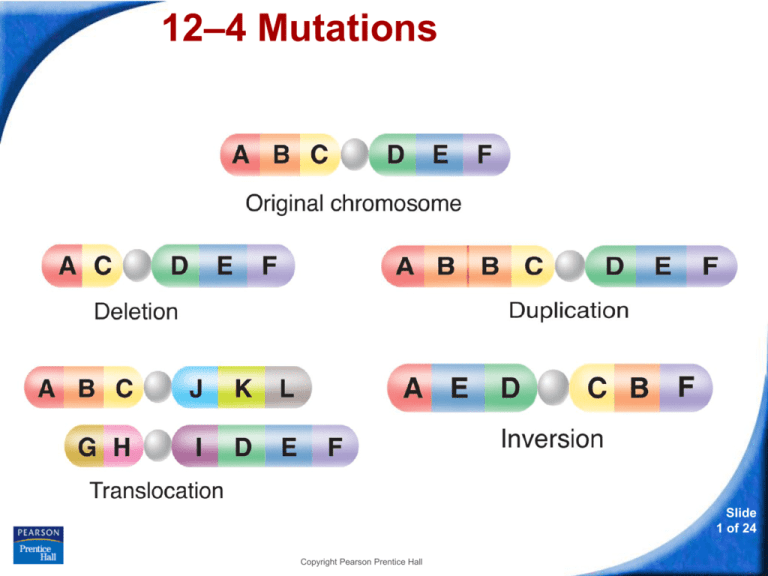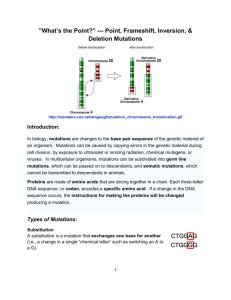
12–4 Mutations
12-4 Mutations
Slide
1 of 24
Copyright Pearson Prentice Hall
12–4 Mutations
12-4 Mutations
What are mutations?
Slide
2 of 24
Copyright Pearson Prentice Hall
12–4 Mutations
12-4 Mutations
Mutations are changes in the genetic
material.
Slide
3 of 24
Copyright Pearson Prentice Hall
12–4 Mutations
Kinds of Mutations
Kinds of Mutations
Mutations that produce changes in a single gene
are known as gene mutations.
Mutations that produce changes in whole
chromosomes are known as chromosomal
mutations.
Slide
4 of 24
Copyright Pearson Prentice Hall
12–4 Mutations
Kinds of Mutations
Gene Mutations
Gene mutations involving a change in one or a few
nucleotides are known as point mutations
because they occur at a single point in the DNA
sequence.
Point mutations include substitutions, insertions,
and deletions.
Slide
5 of 24
Copyright Pearson Prentice Hall
12–4 Mutations
Kinds of Mutations
Substitutions
usually affect no
more than a single
amino acid.
Slide
6 of 24
Copyright Pearson Prentice Hall
12–4 Mutations
Kinds of Mutations
The effects of insertions or deletions are more
dramatic.
The addition or deletion of a nucleotide causes a shift
in the grouping of codons.
Changes like these are called frameshift mutations.
Slide
7 of 24
Copyright Pearson Prentice Hall
12–4 Mutations
Kinds of Mutations
Frameshift mutations may change every amino acid
that follows the point of the mutation.
Frameshift mutations can alter a protein so much that
it is unable to perform its normal functions.
Slide
8 of 24
Copyright Pearson Prentice Hall
12–4 Mutations
Kinds of Mutations
In an insertion, an
extra base is inserted
into a base sequence.
Slide
9 of 24
Copyright Pearson Prentice Hall
12–4 Mutations
Kinds of Mutations
In a deletion, the loss of a single base is deleted and
the reading frame is shifted.
Slide
10 of 24
Copyright Pearson Prentice Hall
12–4 Mutations
Kinds of Mutations
Chromosomal Mutations
Chromosomal mutations involve changes in the
number or structure of chromosomes.
Chromosomal mutations include deletions,
duplications, inversions, and translocations.
Slide
11 of 24
Copyright Pearson Prentice Hall
12–4 Mutations
Kinds of Mutations
Deletions involve the loss of all or part of a
chromosome.
Slide
12 of 24
Copyright Pearson Prentice Hall
12–4 Mutations
Kinds of Mutations
Duplications produce extra copies of parts of a
chromosome.
Slide
13 of 24
Copyright Pearson Prentice Hall
12–4 Mutations
Kinds of Mutations
Inversions reverse the direction of parts of
chromosomes.
Slide
14 of 24
Copyright Pearson Prentice Hall
12–4 Mutations
Kinds of Mutations
Translocations occurs when part of one
chromosome breaks off and attaches to another.
Slide
15 of 24
Copyright Pearson Prentice Hall
12–4 Mutations
Significance of Mutations
Significance of Mutations
Many mutations have little or no effect on gene
expression.
Some mutations are the cause of genetic
disorders.
Slide
16 of 24
Copyright Pearson Prentice Hall
12–4 Mutations
Significance of Mutations
Beneficial mutations may produce proteins with new
or altered activities that can be useful.
Polyploidy is the condition in which an organism has
extra sets of chromosomes.
Slide
17 of 24
Copyright Pearson Prentice Hall
12–4
Click to Launch:
Continue to:
- or -
Slide
18 of 24
Copyright Pearson Prentice Hall
12–4
A mutation in which all or part of a chromosome
is lost is called a(an)
a. duplication.
b. deletion.
c. inversion.
d. point mutation.
Slide
19 of 24
Copyright Pearson Prentice Hall
12–4
A mutation that affects every amino acid
following an insertion or deletion is called a(an)
a. frameshift mutation.
b. point mutation.
c. chromosomal mutation.
d. inversion.
Slide
20 of 24
Copyright Pearson Prentice Hall
12–4
A mutation in which a segment of a chromosome
is repeated is called a(an)
a. deletion.
b. inversion.
c. duplication.
d. point mutation.
Slide
21 of 24
Copyright Pearson Prentice Hall
12–4
The type of point mutation that usually affects
only a single amino acid is called
a. a deletion.
b. a frameshift mutation.
c. an insertion.
d. a substitution.
Slide
22 of 24
Copyright Pearson Prentice Hall
12–4
When two different chromosomes exchange
some of their material, the mutation is called
a(an)
a. inversion.
b. deletion.
c. substitution.
d. translocation.
Slide
23 of 24
Copyright Pearson Prentice Hall
END OF SECTION










